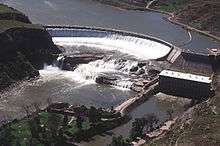Garrison Dam
| Garrison Dam | |
|---|---|
 | |
 Location of Garrison Dam in North Dakota | |
| Country | United States |
| Location | Lake Sakakawea, at McLean / Mercer counties, North Dakota |
| Coordinates | 47°29′55″N 101°24′43″W / 47.49861°N 101.41194°WCoordinates: 47°29′55″N 101°24′43″W / 47.49861°N 101.41194°W |
| Status | Operational |
| Construction began | 1947 |
| Opening date | 1953 |
| Construction cost | US$300 million |
| Dam and spillways | |
| Type of dam | Embankment, rolled earth-fill |
| Height | 210 ft (64 m) |
| Length | 11,300 ft (3,444 m) |
| Width (crest) | 60 ft (18 m) |
| Width (base) | 0.5 mi (1 km) |
| Dam volume | 66,500,000 cu yd (50,842,898 m3)[1] |
| Spillway type | Service, 28 controlled-gates |
| Spillway capacity | 660,000 cu ft/s (18,689 m3/s)[2] |
| Reservoir | |
| Total capacity | 23,821,000 acre·ft (29.383 km3)[2] |
| Surface area | 382,000 acres (1,546 km2) |
| Max. length | 178 mi (286 km) |
| Normal elevation | 1,854 ft (565 m) (max) |
| Power station | |
| Commission date | January 1956–October 1960[2] |
| Turbines | 3 x 121.6 MW, 2 x 109.25 Francis type |
| Installed capacity | 583.3 MW[3] |
| Annual generation | 2,250 GWh[2] |
Garrison Dam is an earth-fill embankment dam on the Missouri River in central North Dakota, constructed 1947-1953. The Three Affiliated Tribes owned the land needed to flood. Short of confiscation by eminent domain the tribes protested and achieved remuneration, but lost 94% of their agricultural land.[4]:59–60 Constructed by the U.S. Army Corps of Engineers from 1947-53 at over two miles (3 km) in length, the dam is the fifth-largest earthen dam in the world.[5] The reservoir impounded by the dam is Lake Sakakawea, which extends to Williston and the confluence with the Yellowstone River, near the Montana border.
Location
Garrison Dam is located between Riverdale and Pick City, named after the town of Garrison, directly north of the dam, across the reservoir. The dam is approximately midway between Bismarck and Minot, about 10 miles (16 km) west of U.S. highway 83.
History
The dam was part of a flood control and power generation project named the Pick-Sloan Project along the river, after the two plan developers, Colonel Lewis A. Pick and William Glenn Sloan. In order to construct the dam, the US government needed to purchase 152,360 acres (616.6 km2) in the Fort Berthold Reservation that would be flooded by the creation of Lake Sakakawea. These lands were owned by the Three Affiliated Tribes, who had been living there "had been their home for perhaps more than a millennium".[6]:234 Threatened by confiscation under eminent domain the tribes protested. A complete block of Garrison Dam power was denied because it would violate the 1935 Rural Electrification Act. The tribes achieved remuneration, but lost 94% of their agricultural land.[4]:59–60 in 1947, when they were forced to accept $5,105,625, increased to $7.5 million in 1949.[4]:61 The final settlement legislation denied tribes' right to use the reservoir shoreline for grazing, hunting, fishing, or other purposes, including irrigation development and royalty rights on all subsurface minerals within the reservoir area.[4]:61 About 1700 residents were forcibly relocated, some to New Town, North Dakota.[7] Thus Garrison Dam almost totally destroyed the traditional way of life for the Three Affiliated Tribes.[4]:p27 Construction on the $300 million dam project began in 1947, and its embankment was enclosed in April 1953. The dam was dedicated by President Eisenhower two months later. The Corps of Engineers completed earthwork in the fall of 1954.[3]
In June 2011, in response to the 2011 Missouri River Floods, the dam was releasing over 140,000 cubic feet per second (4,000 m3/s), which greatly exceeded its previous record release of 65,000 cu ft/s (1,800 m3/s) set in 1997.[8] The first use of the emergency spillway due to flooding started on June 1, 2011 at 8:00am.[9]
Energy generation
Hydropower turbines at Garrison Dam have an electric power generating nameplate capacity of 583.3 megawatts. Average production of 240 megawatts serves several hundred thousand customers.
Fishing
The Garrison Dam National Fish Hatchery is the world's largest walleye and northern pike producing facility and also works to restore endangered species, such as the pallid sturgeon.[10]
References
- ↑ "Garrison Dam/ Powerplant". U.S. Army Corps of Engineers. Retrieved 19 June 2011.
- 1 2 3 4 "Summary of Engineering Data – Missouri River Main Stem System" (PDF). Missouri River Division. U.S. Army Corps of Engineers. August 2010. Retrieved 2012-08-17.
- 1 2 "Facts about Garrison Dam and power plant" (PDF). U.S. Army Corps of Engineers. n.d. Retrieved 19 June 2011.
- 1 2 3 4 5 Lawson, Michael L. (1982). Dammed Indians: the Pick-Sloan Plan and the Missouri River Sioux, 1944–1980. Norman: University of Oklahoma Press.
- ↑ "Garrison Dam and Powerplant". U.S. Army Corps of Engineers. Archived from the original on October 24, 2004.
- ↑ Meyer, Roy W (1977). The Village Indians of the Upper Missouri: The Mandans, Hidatsas, and Arikaras. Lincoln: University of Nebraska Press.
- ↑ "The History and Culture of the Mandan, Hidatsa, and Sahnish". North Dakota Studies curriculum for grades 4 and 8. State of North Dakota. n.d. Retrieved 12 Feb 2012.
- ↑ "Missouri River Mainstem Reservoir Bulletin" (pdf). Army Corps of Engineers. Retrieved 18 June 2011.
- ↑ "Spillway spectacle". Minot Daily News. June 4, 2011. Retrieved 1 December 2014.
- ↑
External links
| Wikimedia Commons has media related to Garrison Dam. |
- Discover ND.com - Garrison Dam: A Half Century Later - June 2003
- U.S. Fish and Wildlife Service - Garrison Dam
- Mandan, Hidatsa, & Arikara Nation.com - article on the Garrison Dam
